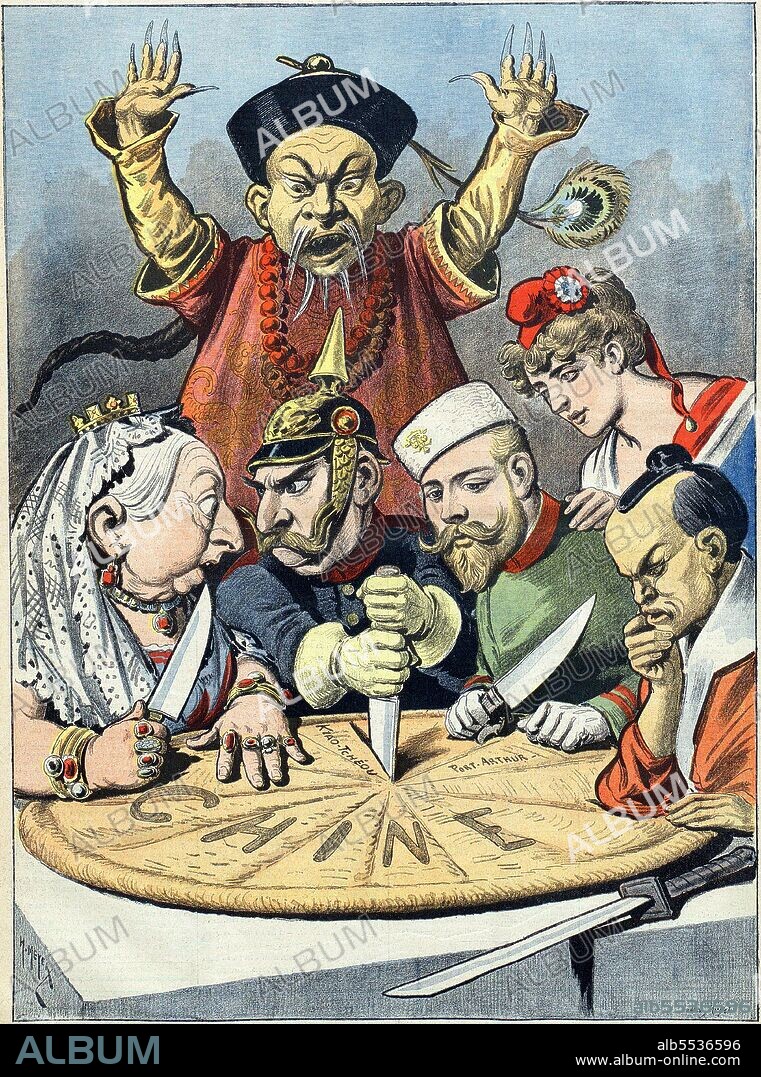alb5536596
France / China: 'Chine, le gateau des rois et des empereurs' ('China, the cake of kings and of emperors'). Political cartoon by Henri Meyer, 'Le Petit Journal',16 January 1898

|
Añadir a otro lightbox |
|
Añadir a otro lightbox |



¿Ya tienes cuenta? Iniciar sesión
¿No tienes cuenta? Regístrate
Compra esta imagen

Título:
France / China: 'Chine, le gateau des rois et des empereurs' ('China, the cake of kings and of emperors'). Political cartoon by Henri Meyer, 'Le Petit Journal',16 January 1898
Descripción:
Traducción automática: En esta caricatura política francesa de 1898, un pastel que representa a China se divide entre caricaturas de la reina Victoria del Reino Unido y Guillermo II de Alemania (que se pelea con la reina Victoria por un trozo de la zona fronteriza, mientras clava un cuchillo en el pastel para significar agresión). intenciones alemanas). También están presentes Nicolás II de Rusia, que está observando una pieza en particular, la francesa Marianne (que diplomáticamente se muestra como no participando en la talla, y representada como cercana a Nicolás II, como un recordatorio de la Alianza Franco-Rusa), y un samurái que representa a Japón, contemplando cuidadosamente qué piezas llevarse. Un funcionario estereotipado de Qing levanta las manos para intentar detenerlos, pero se muestra impotente. El dibujo es una representación figurativa de las tendencias imperialistas de estas naciones hacia China a finales del siglo XIX.
In this French political cartoon from 1898 a pastry representing China is being divided between caricatures of Queen Victoria of the United Kingdom and William II of Germany (who is squabbling with Queen Victoria over a borderland piece, whilst thrusting a knife into the pie to signify aggressive German intentions). Also present are Nicholas II of Russia, who is eyeing a particular piece, the French Marianne (who is diplomatically shown as not participating in the carving, and is depicted as close to Nicholas II, as a reminder of the Franco-Russian Alliance), and a samurai representing Japan, carefully contemplating which pieces to take. A stereotypical Qing official throws up his hands to try and stop them, but is powerless. The drawing is a figurative representation of the Imperialist tendencies of these nations towards China in the late 19th century.
Crédito:
Album / Pictures From History/Universal Images Group
Autorizaciones:
Modelo: No - Propiedad: No
¿Preguntas relacionadas con los derechos?
¿Preguntas relacionadas con los derechos?
Tamaño imagen:
3600 x 4843 px | 49.9 MB
Tamaño impresión:
30.5 x 41.0 cm | 12.0 x 16.1 in (300 dpi)
Palabras clave:
ART • ARTE • ARTES • ASIA • ASIATICO • BOCETO • CARICATURA • CHINA • CHINO • COLONIALISMO • DIBUJO • FRANCES • FRANCIA • HISTORIA • HISTORICO • IMPERIALISMO • INSURRECCION DE LOS BOXERS • LEVANTAMIENTO DE LOS BOXERS • REBELION DE LOS BOXERS • REVUELTA DE LOS BOXERS
 Pinterest
Pinterest Twitter
Twitter Facebook
Facebook Copiar enlace
Copiar enlace Email
Email
